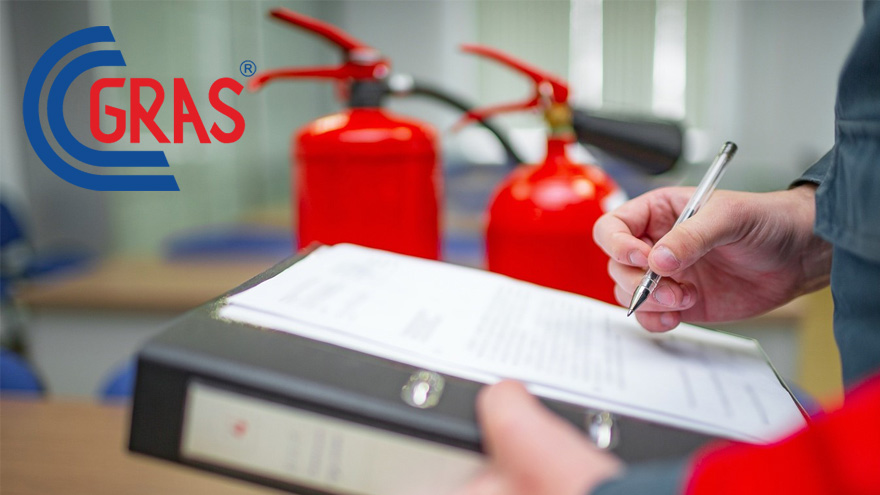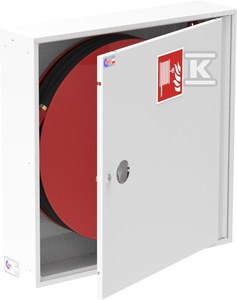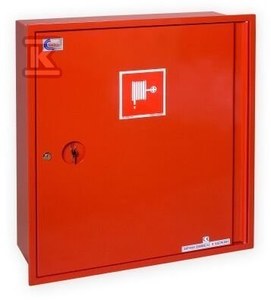Internal and external hydrants are permanent fire extinguishing devices that are a very effective means of fighting fire thanks to immediate access to a continuous water supply. They are available in external (street) and internal variants in buildings. In this text, we present the most important information about this second type of hydrants. If you install such devices, be sure to read our guide!

From this article you will learn:
- how internal hydrants work,
- what types of internal hydrants are there,
- what legal requirements apply to hydrants.
Hydrants - characteristics
Internal hydrants are fire extinguishing devices placed in the hydrant network and used to extinguish group A fires. They allow the fire to be nipped in the bud before the fire spreads and before active fire protection measures are activated. The efficiency and effectiveness of operation depend, among others, on: on a properly designed hydrant system network, its capacity and pressure.
However, it is worth remembering that, in accordance with the regulation, internal hydrants are used only in buildings with separate fire zones classified as a human hazard category ZL and in industrial and warehouse facilities PM. The presence of a hydrant will therefore depend on both the size of the building (mainly its height) and the function it performs.
Internal hydrants are located in special cabinets, made and marked in accordance with the Polish and European Standard PN-EN 671-1 and 671-2. Depending on the type , they consist of a reel, valve, hose and nozzle. Equipment and performance depend on the type of hydrant, which must be adapted to the requirements of a specific building.
Exchange benefits in the new OnnTop loyalty platform!
Types of hydrants
The main division, of course, includes external and internal hydrants. The latter, however, also come in several variants, differing mainly in the diameter of the hose, valve and nozzle. This, in turn, translates into differences in the efficiency and construction of reels or cabinets. This is because each type of indoor hydrants has a slightly different application:
- Internal hydrant DN 25 - used in fire zones classified as hazardous to people ZL, including: in public facilities such as schools, banks or large-scale stores. It is also installed in collective housing buildings, i.e. hotels and boarding houses. Its characteristic feature is a reel for a semi-rigid hose with a diameter of 25 mm and a length of 20 or 30 m. The supply installation on which DN 25 hydrants are mounted should have a cross-section of at least 25mm.
- Internal hydrant DN 33 - semi-rigid hose, must be used in a single-story closed garage with more than 10 parking spaces and in a multi-story garage. They feature a 52 mm diameter valve with a funnel reduction or a DN32 ball valve. Their semi-rigid hoses have a diameter of 33 mm and a length of 20 or 30 m. Regardless of the valve used, the diameter of the supply system should be min. 50mm.
- Internal hydrant DN 52 - are required in production and storage fire zones depending on the fire load density. They are used in production and warehouse buildings (PM). They are equipped with a flat-folding hose with a nominal diameter of 52 mm and a length of 15 or 20 m. The legislator allows it to be supplemented with an additional section of hose if the distance from the emergency exit in a given room exceeds 30 m. The diameter of the supply system on which the hydrants are mounted is DN 52 , should be at least 50mm.
 In addition to the above-mentioned hydrants, protective cabinets for SWSP valves are also used. It is a cabinet equipped only with a valve with a diameter of 52 mm, connected to the power supply system, which in the event of a fire supplies water from fire trucks. This solution is used in tall and high-rise buildings according to the conditions specified in the Regulation of the Minister of Internal Affairs and Administration
In addition to the above-mentioned hydrants, protective cabinets for SWSP valves are also used. It is a cabinet equipped only with a valve with a diameter of 52 mm, connected to the power supply system, which in the event of a fire supplies water from fire trucks. This solution is used in tall and high-rise buildings according to the conditions specified in the Regulation of the Minister of Internal Affairs and Administration
Hydrants and legal requirements
The basic requirements for the installation of internal hydrants are specified in several documents. The most important seems to be the Regulation of the Minister of Interior and Administration of June 7, 2010 on fire protection of buildings, other buildings and areas.
In order to properly understand these regulations, you should familiarize yourself with the definitions and types of fire zones described in the Regulation of the Minister of Infrastructure of April 12, 2002 on the technical conditions to be met by buildings and their location.
Thanks to all these regulations, you will learn the division of buildings according to fire safety, human hazard categories ZL or the classification of buildings in terms of height groups. You will understand where and when particular types of hydrants should be used and what efficiency they should have. Generally, this knowledge is needed by sanitary installation designers and fire safety appraisers for the purpose of assessing and approving the project. However, it is good to have basic knowledge on this subject, because design errors sometimes occur, for which the installer often pays because the Fire Brigade will not accept an installation that does not comply with the regulations.
Check out GRAS hydrants in the wholesaler's offer
Hydrant performance
Each internal hydrant has its own capacity, which is measured at the outlet of the nozzle. Its minimum value depends, of course, on the type of device and its application:
- Fire hydrants DN 25 - minimum water intake capacity is 1.0 dm 3 /s.
- Fire hydrants DN 52 - minimum water intake capacity is 2.5 dm 3 /s.
- Fire hydrants DN 33 - minimum water intake capacity is 1.5 dm 3 /s.
 The relevant Regulation of the Minister of Interior and Administration regulates the method of designing hydrants in buildings, ensuring their coverage of fire zones. Hydrants are placed primarily at entrances, in corridors and at emergency exits from rooms, and in rooms at risk of explosion. Every building owner must remember that the designed fire protection device is intended to protect life and property. The design for the facility and subsequent permanent access to fire protection equipment must be strictly adhered to. For free use in case of fire.
The relevant Regulation of the Minister of Interior and Administration regulates the method of designing hydrants in buildings, ensuring their coverage of fire zones. Hydrants are placed primarily at entrances, in corridors and at emergency exits from rooms, and in rooms at risk of explosion. Every building owner must remember that the designed fire protection device is intended to protect life and property. The design for the facility and subsequent permanent access to fire protection equipment must be strictly adhered to. For free use in case of fire.
Internal hydrants recommended by Onninen
If you are looking for high-quality internal hydrants for the hydrant installation that you perform for your clients, trust the devices of Przedsiębiorstwo Produkcyjno-Handlowe Gras. It is a Polish brand that has been designing, producing and distributing fire protection devices, as well as equipment used in rescue and occupational health and safety since 1985. It specializes in the construction of internal hydrants with semi-rigid and flat-folding hoses.
The Onninen wholesale offer includes internal surface-mounted and recessed hydrants DN 25 . They are equipped with a DN 25 semi-rigid hose in a 30 or less often 20 meter version. The modular design of the hydrant allows it to be configured according to the individual needs of the customer. It is used in the interiors of buildings that fall into the ZL category, such as schools, office buildings, hospitals, sports halls, hotels, cinemas, airports, shopping malls and conference centers.
Another example of a product from this category is a universal internal hydrant DN 33 used in garages, which can be connected to the power supply on the right or left side. W is in accordance with the EN 671-1 standard and equipped with a semi-rigid hose with a diameter of 33 mm in a 30 or 20 meter version.
An internal hydrant DN 52 with a flat-folding hose , which is installed in industrial and warehouse halls (PM), will have a different application than the above two products. The hydrant's design allows for surface-mounted and flush-mounted installation and the selection of the installation's supply side through universal holes on both sides in the cabinet body. The hydrant cabinet is covered with polyester powder paint, making the device perfect for industrial use.
All hydrants are locked with a patent lock with a spare key located on the door behind the glass pane. Other types of locks are also available as optional options.
See what other Gras internal hydrants are waiting for you in the assortment of our online wholesaler.
Offer products from the GRAS Future and GRAS Prestige lines that meet the sophisticated requirements of your customers and provide them with fire protection at the highest level!
Do you have questions about the industry? Join the Świat Instalacji group!